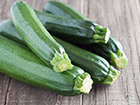


By Linda Ly
Gardeners know that a diverse mix of plants, from annuals and perennials to flowers and vegetables, makes for a healthier garden. But did you know that the right (or wrong) combination of certain plants could actually make them more (or less) productive?
The process is known as companion planting. It is believed that growing certain plants in close proximity to others may help deter pests, promote growth and even improve flavor—or on the opposite end of the spectrum, certain plants, when planted close to one another, may actually stunt each other’s growth.
Learn which flowers and veggies work well together, and which ones should be planted far from one another.
Companion plants are plants that complement one another in terms of growth and production. For example, one plant may attract an insect that might protect a companion plant. Another plant may act as a repellent for a bug that might be harmful to the plant next to it.
It is also important to look at the nutrients individual plants need. A companion plant may need less of one specific nutrient while its neighbor desperately needs it to thrive. In this case, companion planting would eliminate the competition between the two plants.
There are many benefits to companion planting. Most gardeners would agree, the more help you can get to achieve a productive, fruitful garden, the better! What and how can companion planting help?
| Type of Vegetable | Friends | Enemies | Special Notes |
Asparagus |
Basil, carrots, coriander, dill, marigolds, parsley, tomatoes | Garlic, onions, potatoes | Marigolds, parsley and tomatoes protect against asparagus beetles. |
Basil |
Asparagus, beans, beets, bell peppers, cabbage, chili peppers, eggplant, marigolds, oregano, potatoes, tomatoes | Rue | When basil is grown about 1 foot from tomato plants, it will increase the tomatoes yield. It also improves the flavor of lettuce. |
Beans |
Beets, carrots, chard, cabbage, corn, cucumbers, peas, radishes | Garlic, onions | Nasturtiums and rosemary deter bean beetles |
Beets |
Broccoli, Brussels sprouts, bush beans, cabbage, cauliflower, chard, kohlrabi, onions | Charlock, field mustard, pole beans | Pole beans and beets will compete for growth. Composted beet leaves add magnesium to soil when mixed. Magnesium plays an important role in photosynthesis. |
Broccoli |
Basil, beets, bush beans, carrots, celery, chamomile, cucumber, dill, garlic, lettuce, marigolds, mint, nasturtiums, onions, radishes, rosemary, sage, spinach, Swiss chard, thyme | Asparagus, cantaloupe, climbing beans, mustard, peppers, pumpkins, strawberries, sweet corn, watermelon | Rosemary repels the cabbage fly that is detrimental to broccoli. |
Cabbage |
Beets, celery, chard, lettuce, spinach, onions | Kohlrabi, tomatoes | Hyssop, mint, and sage deter cabbage moths |
Carrots |
Beans, lettuce, onions, peas, peppers, tomatoes | Dill | Chives improve flavor, rosemary deters carrot flies |
Corn |
Climbing beans, cucumber, marjoram, peas, pumpkins, squash, sunflowers, zucchini | Tomatoes | Tomato worms and corn earworms like both plants. Beans and peas supply nitrogen. |
Onions |
Cabbage, carrots, chard, lettuce, peppers, tomatoes | Beans, peas | Chamomile improves growth and flavor |
Potatoes |
Basil, beans, celery, corn, garlic, horseradish, lettuce, marigolds, onions, peas, radishes, spinach | Asparagus, broccoli, Brussels sprouts, cabbage, cauliflower, carrots, cucumbers, eggplant, kohlrabi, melons, peppers, raspberries, squash, sunflowers, strawberries, tomatoes | Cucumbers, tomatoes and raspberries attract harmful pests to potatoes. Horseradish increases disease resistance. |
Pumpkin |
Beans, corn, marigolds, nasturtiums, squash | Potatoes | NONE |
Radishes |
Beets, cabbage, carrots, chives, cucumbers, kale, lettuce, spinach, squash | Hyssops | Radish plants will work as a trap crop to protect against certain beetles. |
Squash |
Beans, corn, dill, marigolds, nasturtiums, peas, radishes, strawberries, sunflowers | Potatoes | Squash has similar traits to pumpkin in terms of companion plants. |
Strawberries |
Bush beans, caraway, chives, lettuce, onions, sage, spinach, squash | Cabbage family, eggplants, peppers, potatoes, tomatoes | NONE |
Tomatoes |
Asparagus, carrots, celery, onions, parsley, peppers | Corn, dill, kohlrabi, potatoes | Basil, mint, and bee balm improve growth and flavor |
Zucchini |
Beans, corn, dill, garlic, marigolds, nasturtiums, oregano, peas, radishes, spinach | Potatoes and pumpkin | NONE |
When growing different varieties of plants side by side, try to group them together by water needs. Deep-rooted vegetables like tomatoes and asparagus should be placed in the same bed, as they will thrive with less frequent (but more thorough) watering that soaks deep into the soil.
On the flip side, shallow- to medium-rooted plants like beans and chard benefit from more frequent watering that saturates just the first few inches of soil. Wind soaker hoses around your plants and attach them to dual outlet electronic timers to easily manage your watering schedule for different beds.
Companion planting is a great way to ensure you have a garden that will grow healthy plants and produce large bounties. A lot of work goes into maintaining a productive garden, so it is worth the time, effort and research it takes to grow like-minded plants that will help each other out. And with Gilmour’s guide to companion planting, we take some of the guesswork out of the process for you!
From the moment you pick it up, you’ll notice these nozzles are different. Designed with mobility in mind, they feature Gilmour’s innovative Swivel Connect. The swivel allows the nozzles to pivot without
Learn MoreWinter Gardening Tips to Tackle in the Off Season
As winter marches on, avid gardeners become more and more eager to get growing. While you may not be able to dig your spade into the soil just yet, there is plenty
Learn MoreDesign a Beautiful Drought Resistant Yard
Hot weather and drought-like conditions don’t mean a beautiful yard and garden is out of reach. Learn everything you need to know about drought tolerant landscaping, including the best type of plants,
Get the Dirt